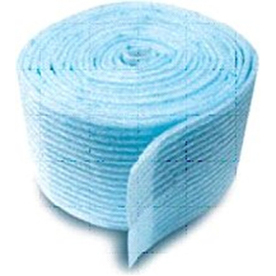
I found the perfect material for adding insulation to my outdoor pet house. Fiber glass is unsuitable because they are for filling cavity that you never touch or breath into. Rigid materials are difficult to cut to size, and do not fit my plastic house with odd corners and odd wall angles. Soft materials are too time consuming to fix onto my plastic walls.
This one looks like some packaging material like packing peanuts. It's like Styrofoam but semi rigid. It's like bubble wrap but it is very dense and the bubbles are not visible. It's cheaper than packaging material - 3.5" x 50' for less than $5.
It's not very thick so it's easy to go around non-flat places. After application it's not bulky so my pet house remains portable, and easy to dissemble for cleaning. It's light weight so I can stick it at the roof with tapes and not worrying something heavy falling down crushing my pet.
It goes very well with sticky tapes. I got clear packing tape 2" x 50m for less than $2. You can tape the insulation to plastic or to other pieces of insulation. Nothing absorb moisture so it will last a long time and the thermal property will not degrade. You can even use it to rain proof something.
The insulation will withstand water and likely steam. The tape may withstand water spraying on it but I'm not sure about soaking and steaming. Washing a big pet house is too much of a hassle. I'll scoop away the dirt and wipe wet spots with newspaper. Occasionally I steam clean the really part. So I don't worry about washing and steaming very much.
The insulation is very difficult to break by pulling, but can be easily cut with a scissor. You can also easily pierce holes in it. I don't feel that big and small pets will want to mess with it. Or, you can always use it only on the roof and on the outside.
The insulation will take adhesive well, such as the caulk adhesive that I use. But I want to rip off some of the insulation in summer, and reuse it the next winter. So I used adhesive tape. If I have a wooden house, I will use staple guns or thumb nails. If you take out the staples carefully, I guess the tiny holes will seal itself.
Because of it's semi rigid property, I can use it for sealing the metal grid door. Leave some extra insulation and it will cover the gaps when the door closes.
For the heater, there's simpler things than my broken low power solder iron. 10W is about right for a small heater. For 110V supply, you need 1.1K ohm resister with > 10W rating. The resister is pretty cheap and so is the electricity consumption.
If you have some cavity to fill, the best and free is supermarket plastic bags compacted. They trap air and do not absorb moisture. I have a two inch high void between the platform and the floor. The bags will get dirty given time. I can just wash them and dry them in the sun. Then use them again or recycle.